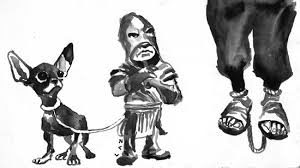 LA HISTORIA DE JOSÉ MARÍA PERAZA, ALIAS “MATAPERROS”, EL MÁS CELEBRE VERDUGO CUBANO.
LA HISTORIA DE JOSÉ MARÍA PERAZA, ALIAS “MATAPERROS”, EL MÁS CELEBRE VERDUGO CUBANO.
Esta es la historia de un celebre verdugo que tuvo Cuba y que alcanzó notoriedad por su tranquilidad en el momento de dichas ejecuciones
y la de una agitada vida que le dió a conocer en toda la isla de entonces. Su alias fue el de “Mataperros”.
José María Peraza, nacido en Diciembre de 1744 era oriundo de un pequeño pueblo cerca de la actual villa de Trinidad donde tuvo que enfrentar la condena de morir en la horca por haber asesinado a su mujer a cuchilladas. Pero es que entonces sus acusadores no pudieron aplicar la sentencia por no haber en alli un “ministro ejecutor” en la villa. Ni la de otro reo que esperaba ser ejecutado en el mismo pueblo. Por lo que fueron referidos para ser ajusticiado por el ejecutor de la vecina ciudad de Santa Clara, pero que por fortuna de José María el hombre murió durante el viaje.
Peraza propuso, a cambio de salvar la vida, que el mismo desempeñaría el cargo de verdugo. Así, con su antiguo compañero de prisión, inició un siniestro rosario de ejecuciones.
Luego de ganar cierta fama como verdugo fue nombrado ‘Ministro ejecutor’ de la ley. Este era un gran nombramiento y así, Peraza comenzó a ser el brazo de la justicia para eliminar delincuentes. Era el apogeo del bandolerismo. Se dice que, en una ocasión, hasta mató un chino que no se defendió adecuadamente con el juez. José María llegó a coger una triste fama por su gran habilidad con la soga. Adquirió una destreza poco común en su profesión.
De Peraza se cuenta que no era raro que una vez que lanzaba del tablado al reo, se trepaba a la horca y bajaba por la soga hasta quedar a horcajadas en los hombros del ajusticiado. Entonces le propinaba patadas en el pecho para acelerar su muerte. Un día, mientras realizaba esta maniobra, la soga se rompió. Reo y verdugo quedaron confundidos en un macabro abrazo, pero hombre estaba aún vivo. No faltó quien gritara ¡Milagro! y la pena fue conmutada.
Hubo algunas épocas en las cuales los «clientes» de Peraza podían hacer una fila. En otras épocas el hombre no tenía mucho trabajo.
La remuneración de José María Peraza era de 125 pesetas por cada ejecución. Se las arrojaban sobre el tablado. El hombre las recogía y luego agradecía al público. Se cuenta que nunca utilizó ese dinero para sus propias necesidades. Segun lo que lo conocieron el verdugo lo repartía entre los pobres como limosna y mandaba a decir misas por la salvación del alma de los ajusticiados
¡Cómo había cambiado José María!.
Un día tomó por sorpresa a no pocos que dejaría el oficio por su edad y ya no ahorcaría a nadie más. No obstante, se convertiría en la primera persona en Trinidad en usar el garrote vil. Un bandolero muy conocido por aquellos lares que llevaba preso durante 20 años fue el primero en morir al garrote, ya que la ley establecía que a los 21 años se le dejaría en libertad.
Un dato curioso sobre aquel verdugo es que mandaba a dar una misa por el alma de los que morían a manos suyas.
Tras unos veinte años en este peculiar oficio, se le dio el trabajo de Mataperros municipal, de allí su apodo. Se le complicó el trabajo, pero le pusieron un ayudante. Su destreza como verdugo la usaba para evitar hacer sufrir inútilmente a los animales. Algunas veces la cosa se ponía fatal y los perros lo mordían. Pero ya su espíritu no sufría de remordimientos por los ahorcamientos. La remuneración no era tan buena como siendo verdugo, pero de algo le servía.
En esa época cuando los niños se ponían majaderos y no lograban que hicieran caso, sus madres les decían: «Ahí viene el Mataperros», y los muchachos se tranquilizaban.
En ese entonces Peraza vivía en un bohío fuera de la ciudad. Sembraba sus alimentos y algún que otro vecino le llevaba un poco de comida. Al envejecer vivió de la caridad pública, en soledad con sus recuerdos.
Las mujeres de Trinidad llevaban sus limosnas hasta la choza de Peraza, pero se volvían de espaldas al acercarse a la cesta que Mataperros tenía dispuesta para recibir las dádivas, para no ver la cara del antiguo verdugo.
Mataperros murió a los 103 años de edad, en 1847. Pese a su funesta trayectoria fue una gran persona, que daba lo poco que tenía a quienes lo necesitaran. No se sabe a donde fue a parar su alma despues de su muerte y supuesta ascension al cielo.
 THE STORY OF JOSÉ MARÍA PERAZA, ALIAS “MATAPERROS”, THE MOST CELEBRATE CUBAN EXECUTOR.
THE STORY OF JOSÉ MARÍA PERAZA, ALIAS “MATAPERROS”, THE MOST CELEBRATE CUBAN EXECUTOR.
This is the story of a famous executioner that Cuba had and who achieved notoriety for his tranquility at the time of these executions
and that of a hectic life that would be known to him throughout the island then. His alias was “Mataperros”.
José María Peraza, born in December 1744, was a native of a small town near the current town of Trinidad where he had to face the sentence of death by hanging for having stabbed his wife to death. But it is then that his accusers could not apply the sentence because there was not an “executing minister” in the town. Nor that of another inmate who was waiting to be executed in the same town. So they were referred to be executed by the executor of the neighboring city of Santa Clara, but fortunately for José María, the man died during the trip.
Peraza proposed, in exchange for saving his life, that he himself would serve as executioner. Thus, with his former partner in prison, he began a sinister string of executions.
After gaining certain fame as an executioner, he was appointed ‘Executing Minister’ of the law. This was a great appointment and thus, Peraza began to be the arm of justice to eliminate criminals. It was the height of banditry. It is said that, on one occasion, he even killed a Chinese who did not defend himself adequately with the judge. José María became famous for his great skill with the rope. He acquired a rare skill in his profession.
From Peraza it is said that it was not uncommon for once he threw the prisoner off the platform, he climbed onto the gallows and descended the rope until he straddled the shoulders of the executed person. He would then kick him in the chest to hasten his death. One day, while performing this maneuver, the rope broke. The inmate and executioner were confused in a macabre embrace, but the man was still alive. There was no shortage of people shouting Miracle! and the sentence was commuted.
There were times when Peraza’s “clients” could line up. At other times the man did not have much work.
José María Peraza’s remuneration was 125 pesetas for each execution. They were thrown on the stage. The man collected them and then thanked the audience. It is said that he never used that money for his own needs. According to what they knew, the executioner distributed it among the poor as alms and ordered Masses to be said for the salvation of the soul of those executed
How José María had changed!
One day he took quite a few by surprise that he would leave the job because of his age and would no longer hang anyone else. However, he would become the first person in Trinidad to use the “guillotine”. A well-known bandit in those parts who had been imprisoned for 20 years was the first to die with the stick since the law established that at the age of 21 he would be released.
A curious fact about that executioner is that he ordered a mass to be given for the souls of those who died at his hands.
After some twenty years in this peculiar trade, he was given the job of municipal Mataperros, hence his nickname. His work was complicated, but they gave him an assistant. His skill as an executioner was used to avoid making the animals suffer uselessly. Sometimes it got awful and the dogs would bite him. But his spirit no longer suffered from remorse for the hangings. The pay was not as good as being an executioner, but it served him well.
At that time, when the children got stupid and couldn’t get them to listen, their mothers told them: “Here comes the Dog Slayer,” and the boys calmed down.
At that time Peraza lived in a hut outside the city. He sowed his food and the occasional neighbor brought him some food. As he aged he lived on public charity, along with his memories.
The women of Trinidad carried their alms to the hut in Peraza but turned their backs as they approached the basket that Mataperros had ready to receive the gifts, so as not to see the face of the old executioner.
Mataperros died at 103 years of age, in 1847. Despite his disastrous career, he was a great person, who gave what little he had to those who needed him. It is not known where his soul went after his death and supposed ascension to heaven.
Agencies/ Ciro Bianchi/ Extractos/ Excerpts/ Internet Photos/ Arnoldo Varona/ www.TheCubanHistory.com
THE CUBAN HISTORY, HOLLYWOOD.








